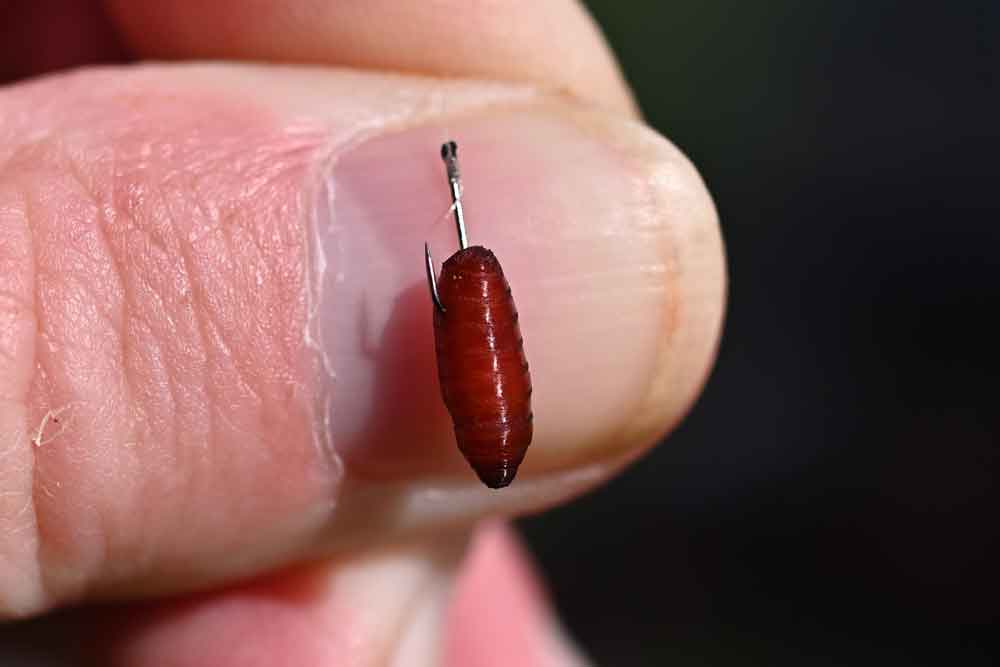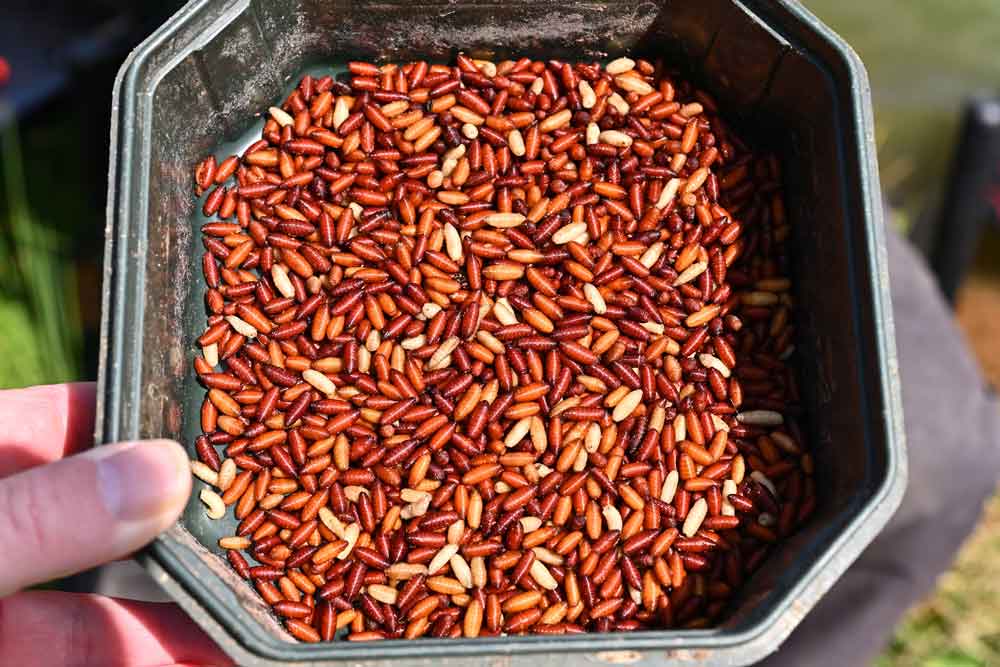Casters – The Bait That Won’t Go Away
Dave Coster explains how lethal casters can be, even in these pellet orientated times.
Top Drawer
Bait fads come and go, but good old favourites like casters never completely disappear off the menu. Even if I intend to use some other form of attack, I normally have a bag of casters in reserve. It’s amazing how many times they have turned sessions around, finding fish that didn’t initially show any signs of being present. On most outings, I take a few maggots with me as well, but casters are the main option I like to turn to. They need to be in tiptop condition, which means not rubbery, turning grey, or showing signs of bag burn. Unless I can buy super fresh, I turn my own shells, which is a bit of a pain. A bait fridge is required, along with a lot of fussing around. It takes several days of riddling to get what I need; on the dark side, but not quite at the floating stage. All the effort is worth it when you have confidence in what you are using, which is just as important as the fish wanting to eat it.

Ready for Action
Casters require clever presentation. They attract wily fish that rarely get caught, so everything that goes with them needs to be smooth running. None more so than pole elastic, which I’m very particular about. Edge Hybrid and Hollow ranges provide great selections that deal with all eventualities, covering extremely light to super strong rigs. I lubricate elastic first thing, using a hair conditioner that’s been slightly diluted with water. I’ve tried silicone, but found it kept gumming up, requiring regular attention. That’s not the case with my concoction, which comes from a discount store and is cheap, lasting ages. Just a few drops keep the pole elastic running perfectly for a whole session. Afterwards, I pull out as much of the shock absorber as I can from its top kit and run it through a towel. Removing moisture before storing away, prevents premature perishing.

On the Hook
My favourite caster hooks are Sensas Black 3405s in size 16, 17 and 18, along with similar Hayabusa CHK128s, also Drennan Barbless Silverfish Match in size 20. The first two models are black nickel and have round bends, while the bronze Drennan design features a wide gape crystal shape. I generally prefer the round profile, but switch to the crystal with my shallowest rigs, finding it bumps fewer fish when they are competing for casters near the surface. I use Edge Premium Mono in its lighter gauges. It’s super fine, supple and crystal clear, helping hook baits to behave as naturally as possible. Different ways of hooking casters involve partly burying the hook through the thick end when catching at speed, or completely burying it as a last resort if bites are difficult to come by. I hook maggots through the fat end too, but more lightly, so they are free to wriggle in an enticing manner.

Close to Hand
Pole rigs take up over half the storage space in the drawers and trays in my seat box. Quite a few of these are caster orientated. The most popular winder sizes are 14mm, 16mm and 18mm, while 20mm and 26mm ones are used for even longer and bigger bodied floats. I also use trimmed down 10mm winders, modified for shorter dibber rigs, which would otherwise take up too much room. I use stick-on labels that carry important information about line strength, rig length, shotting, hook size and pattern. Furthermore, I note the turns of line on each winder, which tells me if they match top 2, 3, 4 or 5 top kits. I also carefully record shot numbers and sizes. As an example, knowing a float carries 6 number 8s as a spread bulk, with 3 number 11 droppers spaced out below, saves me having to test the tackle in water should a rig need to be remade, or if a weight accidentally gets lost.

Barbed or Barbless
I use barbless hooks most of the time because they are a lot easier to extract and generally kinder. Another benefit with barbless is they don’t tend to bump out of lively fish, particularly if they are only lightly attached. Conversely, if a barb hasn’t sunk in properly, it can act like a buffer, causing a hook to lean over and fall out. Some say you need barbed patterns to keep live baits like maggots or worms from wriggling off, but that rarely happens with barbless designs in my experience, even with feeder tackle. A rare occasion I would consider using a micro barb is for pole fishing when there are high banks behind. In this situation, you need to raise the lower pole sections up while bringing fish in, so they can be guided over the bank. This dramatically changes the angle of pull, which can cause the tackle to come loose when using barbless. If I don’t want a barb, I flatten it with pincers.

Telltale Signs
Having to use a disgorger confirms your tackle and bait presentation is good, while if you are missing plenty of bites, something is probably wrong. As mentioned previously, it pays to experiment with the way casters are hooked, along with regular tackle adjustments to try to make the bait behave as naturally as possible. Just a tiny tweak by moving a dropper shot, changing depth, altering how you are feeding or how you are manipulating a rig, is often enough to make a difference and gain more positive interest. Without experimenting, you never know what you might be missing. Scaling down hook size and line diameter is another way of catching more when the going gets tough. Casters work at various depths, whether swims are shallow, deep, standing still, or flowing. You need to stay alert to find where the fish are intercepting them. This is not a lazy angler’s bait!

Top Tactics
When casters attract quality fish like this, I’m happy, loving the challenge of keeping them interested, striving to put a good catch together. One of the most vital ingredients for that is the way swims are fed. I typically kick-start sessions with groundbait, containing a mixture of casters and chopped worm. I might also add some hemp or micro pellets, depending on the species being targeted. Hemp is better for roach, while micros are superior for skimmers and larger bream. Sometimes, if there’s a big head of small perch, it might be better to exclude worm feed. Then again, although these fish can be a nuisance, another option is to get your head down and target them for a while. If you keep loose feeding casters over the top, all the activity invariably attracts bigger perch, along with fish like roach, rudd, skimmers, and hybrids. It’s a fine balancing act, but satisfying when things go right.

Staying Busy
A catapult is rarely out of my hands, even when holding one of my Cadence poles. I feed a small group of casters every put in, working my rig in unison with them, which is vital when fishing shallow. Big roach and other silvers respond to these tactics on all types of venues, even deeper ones, competing up in the water for the regular free offerings. For pole work, a light action catapult with short, thin and soft elastics is best. Using longer lengths of latex, like many catties are supplied with, tends to cause twisting and tangles. Too much rubber also makes gauging distances harder and puts the pouch too far away for easy one-handed filling, particularly when it’s draped over a bait box. It’s best to have an identical spare catty for busy work like this because fine hollow latex wears more quickly and will break eventually. Any interruptions to regular feeding risks losing a shoal.

Getting Bigger
Feeding robotically with casters and catching steadily is an ideal recipe for bigger fish to move in. This favourite match technique can unearth many surprises, such as big hybrids, crucians and stillwater chub. It’s caught me specimen sized roach and rudd, even slab-sided bream that have strayed up near the surface, along with some cracking perch. But it’s quality roach I love catching most, trying to tease them into having a go, even when conditions are bright and tricky. Talking of tricks, an effective one for this species is to let your rig run with any drift there might be. This is because even a slight current can carry free casters further than you might think. Crafty bigger fish soon cotton onto this and hang back from the rest of the shoal. Letting a float move naturally, even on stillwaters, can find these bonus red fins. Regularly trying new depth settings is similarly effective.

Caster Comeback
Casters are not used anywhere near as extensively as they once were, but are still capable of being devastatingly effective. If others want to rely on more convenient baits, that’s fine, leaving me to enjoy catching superb fish like this. But I have noticed a wind of change. Some tackle shops don’t turn their own casters any more, but those that do seem to be busier. This might be due to carp puddles, where pellets have been fed to death for many years, prompting some anglers to try changing to a shell attack. The popularity of F1 carp has had an influence, where thanks to their crucian heritage, these hybrids love casters. It’s a bait that’s being rediscovered by many, giving the chance of unlocking shoals of silver fish that thrive in many commercial fisheries. Apart from making a comeback, casters have even survived the metric age, still being sold by traditional pint measures.

Quality Counts
These fresh and crispy casters are mostly on the dark side, very close to turning into floaters. The darker the shells are, the slower they sink, attracting lots more interest. Dark casters enticingly stir up from the bottom more easily, too, particularly when fish are grubbing around over ground baited areas. But there comes a time when you need to keep bait like this in water, to prevent it from going too dark and becoming buoyant. Fresh, perfect bait can be fridged in a polythene bag, but needs to be shaken and breathed every day, to keep it alive and from suffering bag burn. I prefer to use self-sealing food bags, which are easier to open than knotted plain versions. A top tip is to put fresh casters in a small brown paper bag, before sealing them off inside a plastic one. This keeps them fresher for longer, up to 5 or 6 days, providing you air the bait for a few minutes every 24 hours.

Perfect Pints
A pint of casters is normally enough for a busy pole session, which can result in a great catch of quality roach like this. Soft groundbait helped to kick-start things and to bring back interest after slow spells. When switching to waggler tackle, I make a pint of casters go further by feeding them alongside hemp or slightly damp 3mm pellets. Both baits fire roughly the same distance as casters (or maggots) with a catapult. Hemp is better for roach and chub, while pellets often attract skimmers and bigger bream. I rarely ignore casters when using open-end feeders, mixing them into groundbait, alongside baits like chopped worm, micro pellets and hemp seed. Again, a pint bag is normally ample for a session. Another option with casters is to use them with minimal dark groundbait in a small cage feeder, alongside hemp or micro pellets. This method usually unlocks hard, clear water venues.


Superb article, my favourite bait which I use for 90% of my fishing a long with hemp and tares.
Enjoyed that, it’s wet and windy Thursday in December. Looking forward to the spring pole fishing.